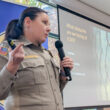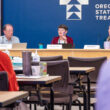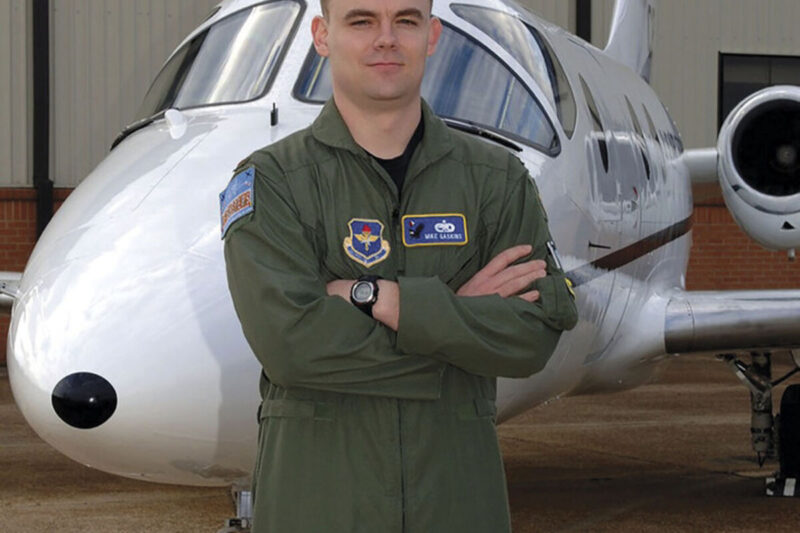Scott Swanson
Sweet Home alum Michael D. Gaskins had served four years in the Air Force and was thinking about getting out and going to college when he had a “defining moment.”
When terrorists slammed jetliners into the World Trade Center and the Pentagon on Sept. 11, 2001, Gaskins said, he had a change of heart.
When he finally left, on June 1 of this year, he retired after 23-plus years in the service.
Gaskins, 42, finished as chief pilot of the 93rd Air Refueling Squadron based at Fairchild Air Force Base in Spokane, Wash.
He was an evaluator pilot on the KC 135R/T aircraft, a tanker that refuels jets, and was responsible for validating the training of 121 air crew members to provide all-weather, in-flight refueling for U.S. and allied aircraft.
He received a Meritorious Service Medal at his retirement.
Gaskins moved with his mother Cathy Gibson and sister Christine in 1987 to Sweet Home, where his grandparents Dave and Bridget Cooper operated The New Era. He was involved in Scouts and active in a variety of sports while growing up and at Sweet Home High School – football, baseball and track. He participated in the Josai summer exchange program during the summer of his junior year and was active in the youth group at Cornerstone Fellowship church.
After he graduated in 1997, he enlisted in the Air Force.
“The military interested me,” Gaskins said. “I loved airplanes. My dad was in the Army and he was saying that if I was going to join the military, I should think about the Air Force.
“One of the questions I had for the recruiter was ‘How close can I work to airplanes?'” He said I could be an F-15 crew chief, which was a fancy way of saying I would be fixing airplanes, a mechanic.”
That’s what he ended up doing, stationed at Seymour Johnson Air Force Base in North Carolina.
Nearing the end of his first enlistment, he had developed some other goals.
“I was actually one foot out the door at the end of my first enlistment,” Gaskins said. “I was planning to leave the military and go to school.”
Then 9/11 happened.
“I remember distinctly going into work that morning as an F-15 crew chief,” he said. “For the first time in my life, that was the real world.”
Operation Noble Eagle, the military’s homeland defense mission, officially began the next day, Sept. 12, 2001. U.S. Air Force, Air National Guard and U.S. Navy fighters began flying combat air patrol missions over major cities and critical infrastructure locations such as power plants, bridges, airports, and port facilities across the United States.
Those sites were covered on a continuing basis for several months before a gradual phase-down of Noble Eagle operations began.
“That changed my whole outlook,” Gaskins said. “The next day I had a conversation with my commander about whether I could pull my (discharge) paperwork. I knew it would be only a matter of time before we were overseas, as we figured out how to respond to 9-11.”
He also decided to pursue a four-year college degree, graduating in 2005 with a bachelor’s in computer information systems from the University of Mount Olive, which offered night classes at Seymour Johnson.
“I was definitely on the slow roll program,” he said, chuckling. “It took me about six years to get my degree. I was working long hours as a crew chief and going to school at night, getting credits when I could.”
He finished in 2005 and, two years later, was selected for Officer Training School at Maxwell Air Force Base in Alabama, where he was a distinguished graduate. He went on to complete undergraduate pilot training at Columbus Air Force Base in Mississippi in 2009.
Gaskins was deployed eight times to the Middle East, including Kuwait, Qatar, Turkey and Afghanistan. He flew tanker missions in Iraq, Syria and Afghanistan and, for three years, flew remotely piloted aircraft (RPAs) – drones – in locations he can’t talk about.
“I went to fly drones at the height of the ramp-up for drones, the newest, shiniest penny,” he said, reverting to military parlance.
During that period he was stationed at Creech Air Force Base in Indian Springs, Nev., north of Las Vegas.
“You’re flying a drone that’s on the other side of the planet,” Gaskins said. “Your primary mission is reconnaissance. You’re basically watching bad guys do bad stuff and a component of that is that if they end up doing something that is going to cause harm, be dangerous to friendlies or U.S. servicemen or women, we end up using weapons.
“I tell people I was happy to do that, but I was happy to leave. It was stressful. It is an important mission, but I was itching to get back into a normal airplane.”
At retirement, Gaskins had flown 229 combat missions and 344 combat support missions over his career, for a total of 4,000 hours in the KC-135 and RPAs. He’s air-refueled many different types of aircraft throughout the United States, including at 24,000 feet over Foster and Green Peter.
Contacted last week, Gaskins was enjoying retirement, shuttling his kids, son Matthew and daughters Emily and Sophie, home from school in Spokane, where he and his wife Katie reside.
He’s not sure what’s next.
“I’m really interested in trying to stay home,” he said. “I’ve been on the road so much during the past 20 years. I have this little window of freedom and it’s hard to let go of, doing whatever I want whenever I want.”
Airlines are hiring pilots again and he’s thought about the possibility of flying air tankers to fight forest fires, which is a job that’s always open.
“I’ve thought that KC-135s would make good air tankers,” he said, noting that the Holiday Farm fire last fall came within five miles of the home of his aunt and uncle, Cindy and Chuck Sieg.
“That definitely has crossed my mind, a potential career I’d be interested in.”
Meanwhile, he’s just enjoying retirement and fond memories of the military.
“To sum it up, it would be the people,” Gaskins said. “There’s a certain amount of satisfaction you get from completing a mission that’s very gratifying, but it probably is equally or more gratifying to do it with a group of people you care about, when you work together to make it happen.”





